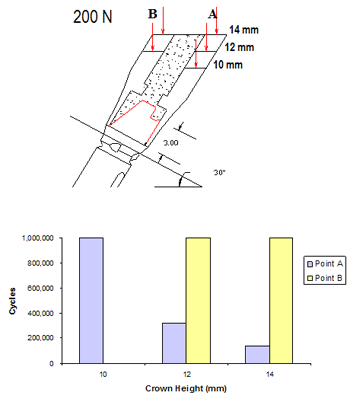| Norman Kwan, DDS, MS, Yang, Silvia: The Canadian Dental Implant Institute, 206 King St., St. Catharines, ON L2R 3J7, Canada; Didier Guillaume, DMD; Hoda Aboyoussef, DMD, MS; Scott D. Ganz, DMD; Saul Weiner, DDS, Department of Restorative Dentistry, New Jersey Dental School 110 Bergen Street, University Heights, Newark, NJ, 07103, USA � |
|
 The purpose of this study was to evaluate the resistance and retention of a hexagonal abutment to crown displacement with varying crown heights (10, 12, and 14 mm) and axis of load. The purpose of this study was to evaluate the resistance and retention of a hexagonal abutment to crown displacement with varying crown heights (10, 12, and 14 mm) and axis of load.
Implants were embedded in resin blocks at a 30° angle to the vertical. Crowns were made at heights of 10, 12, and 14 mm. Groups of 5 crowns for each of the 3 crown heights were loaded (200 N) both under the long axis and off axis. The marginal gaps were measured using standardized periapical radiographs before and after loading. The gaps were statistically compared using a 3-way analysis of variance with factors of load, crown height, and point of load. Crowns were loaded to 10^6 cycles or point of failure.
The 10-mm crowns did not show any displacement. The 12-mm and 14-mm groups only showed displacement of the off axis-loaded crowns. The average marginal displacement was 193.56 µ (standard deviation [SD] ± 138.62 µ ) at point of failure (320,717 cycles) and 400.18 µ (SD ± 644.31) at point of failure (134,278 cycles), respectively.
A 1-piece implant with a standardized abutment designcan provide sufficient resistance and retention form for crowns of varying dimension if loads are centered over the long axis of the crown. (Implant Dent 2004;13:112-119)
|